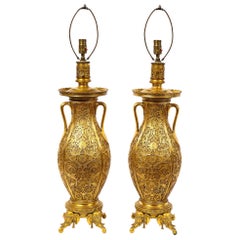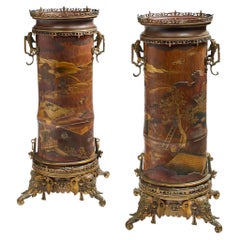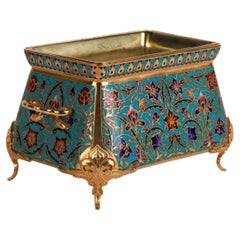Edouard Lievre Lighting
1
to
1
1
1
1
1
Height
to
Width
to
1
1
1
1
1
2
1,441
1,355
1,250
1,090
Creator: Edouard Lievre
Pair of French Japonisme Ormolu Vases E. Lièvre, Executed by F. Barbedienne
By Ferdinand Barbedienne, Edouard Lievre
Located in New York, NY
An important and monumental pair of very fine 19th century French Japonisme/Orientalist ormolu vases designed by Edouard Lièvre and Executed by Ferdinand Barbedienne. Each body with an oval shape, finely sculpted in a floral design, fringed by orientalist style handles with cartouches, the neck surmounted by a circular pierced scrolling dragon frieze. Each vase resting on a group of four orientalist style jeweled elephant...
Category
1870s French Japonisme Antique Edouard Lievre Lighting
Materials
Bronze
Related Items
French 19th Century Pair of Lacquered Bamboos Japonisme Vases
By Edouard Lievre, Ferdinand Barbedienne
Located in Saint-Ouen, FR
A 19th French century pair of Lacquered Bamboos Japonisme vases.
An amazing pair of tall cylindrical bamboo vases decorated in Japanese Gold and Sil-ver Hiramaki-E Lacquer with Pavilions in The Mist and Weaving Figures, Flown Over by a Pair of Cranes. Enclosed in a Sino-Japanese Inspiration Golden and Brown Patina Bronze Mount Featuring Elephant Heads, Partially Openwork Branches and Salamanders Forming Side Handles.
Circa 1870
Attributed to Édouard Lièvre (1828-1886) and Ferdinand Barbedienne (1810-1892)
Édouard Lièvre (1828-1886) is one of the most talented and prolific designer and industrialist of the 19th Century, his repertoire is sometimes Sino-Japanese or Neo-Renaissance, whether in furniture or works of art, we can note in particular the parade bed of Valtesse de La Bigne, furniture commissioned by the painter Édouard Detaille or even Sarah Bernhardt, and the famous works in collaboration with Maison Christofle or those in gilded bronze and cloisonné enamel edited by Ferdinand Barbedienne, presented at the Universal Exhibitions in 1878, 1889 and 1900.
He was both a draftsman, painter, illustrator, engraver, ornamentalist and cabinetmaker, first trained in the studio of the painter Thomas Couture, Lièvre was then fully immersed in the world of decoration, creation and ornamentation and provides designs for manufacturers and merchant-publishers.
Often assisted by his brother Justin, he first produced works of art for his own apartment, seeking out the finest craftsmen to execute his designs for bronzes, ceramics, fabrics and luxury furniture from great virtuosity and great taste. He then collaborated with the cabinet-maker Paul Sormani, as well as haberdasher merchants such as the Escalier de Cristal, bronziers such as Maison Marnyhac and especially Ferdinand Barbedienne as on our vases with bronze mounts characteristics of Edouard Lièvre's work.
Born in 1810, died in Paris in 1892, Ferdinand Barbedienne, the most important caster of bronze pieces of art during the second half of the 19th Century, created and directed in Par-is one of the major artistic foundries of his time. Barbedienne specialized in classical reproductions, whose models were exposed in famous European museums. Their illustrated catalogues included many diverse objects such as busts, ornemental sculpture (clocks, candelabras, cups) sometimes even life-sized and bronzes for furniture. Apart from his own produc-tion, Barbedienne worked for the most renowned sculptors such as Barrias, Clésinger and Carrier-Belleuse. All his works were highly esteemed and he, himself honored by contemporary critics. At the London exhibition in 1851 Barbedienne’s firm won two « Council medals ». At the 1855 Universal Exhibition, he won a medal of honor. The success of Barbedienne’s firm brought him many official commissions, such in about 1860, as Barbedienne supplied bronzes for furniture for the Pompeian Villa of Prince Napoléon-Joseph, located avenue Montaigne in Paris. At the London Universal Exhibition of 1862 Barbedienne won medals in three different categories: Furniture, Silversmith work and Artistic bronzes. Barbedienne was made an officer of the Légion d’Honneur in 1867 and Commander in 1878 when he was compared with « a prince of industry and the king of bronze casting ». His glory did not decline with the passage of the time for at the Universal Exhibition of 1889 the critics thanked Barbedienne for the example he set for other bronze-casters by the perfection of his bronzes.
“Japonisme” in the second half of the 19th century, was a craze for everything that came from Japan or imitated its style. The word was first coined in a series of articles published by Philippe Burty, from May 1872 to February 1873, in the French magazine “la Renaissance Littéraire et Artistique”. Far from the Academic sphere, artists seeking for new ways of expression, appropriated this discovery. Manet and the impressionists led the way to half a century of enthusiasm for Japanese art, and largely contributed to the esthetical revolution Europe experienced between 1860 and the beginning of the twentieth century.
From 1862, The World’s Fairs provoked massive arrivals of fans, kimonos, lacquers, bronzes, silks, prints and books that launched the real era of Japonisme. With those exhibitions, the demand was boosted, the number of merchants and collectors was multiplied, and artists became passionate about this new esthetic. For them, its “primitivism” was probably its most important quality: artists were fond of the Japanese art’s capacity to be close to nature and to reconcile art and society by representing, with a lot of care, the most trivial objects.
In painting, Edouard Manet, Mary Cassatt, Degas, Van Gogh, Gauguin were among those who were deeply inspired by Japanese art, affected by the lack of perspective and shadow, the flat areas of strong color, the compositional freedom in placing the subject off-center, with mostly low diagonal axes to the background. The Japanese iris, peonies, bamboos, kimonos, calligraphy, fish, butterflies and other insects, the blackbirds, cranes and wading birds, the cats, tigers, and dragons were endless sources of inspiration, appropriation, and reinterpretation for European artists. The occidental productions were combining styles and artistic conceptions instead of copying Japanese art slavishly. That is what brings to light the comparison between the artworks of Kitagawa Utamaro and Degas, of Katsushika Hokusai and Van Gogh
The World’s Fairs of 1851 and 1862 in London, those of 1867, 1878, 1889 and 1900 in Paris, of 1873 in Vienna and of 1904 in Saint Louis presented a number of “Japanese-Chinese” installations with earthenware, bronzes, screens and paintings and attracted the largest amounts of visitors In Vienna, the “Japanese village...
Category
1870s French Japonisme Antique Edouard Lievre Lighting
Materials
Bronze
Ferdinand Barbedienne, A French Ormolu and Champleve Enamel Jardiniere, C. 1870
By Ferdinand Barbedienne, Louis-Constant Sevin
Located in New York, NY
Ferdinand Barbedienne, A French Ormolu and Champleve Enamel Jardiniere, C. 1870, The Design Attributed to Louis Constant Sevin.
An exceptional qualit...
Category
19th Century French Napoleon III Antique Edouard Lievre Lighting
Materials
Bronze, Enamel, Ormolu
No Reserve
H 5 in W 8 in D 5 in
Ferdinand Barbedienne, A French Ormolu and Champleve Enamel Vase, C. 1870
By Ferdinand Barbedienne
Located in New York, NY
Ferdinand Barbedienne, A French Ormolu and Champleve Enamel Vase, C. 1870
In the Islamic / Alhambra taste. The two handled vase in Alhambra form, enameled in rich yellow throughout ...
Category
19th Century French Napoleon III Antique Edouard Lievre Lighting
Materials
Bronze, Ormolu, Enamel
F. Barbedienne, A Suite of Three French Ormolu and Champleve Enamel Jardinieres
By Ferdinand Barbedienne
Located in New York, NY
Ferdinand Barbedienne, An Exquisite Suite of Three French Ormolu and Champleve Enamel Jardinieres / Garniture C. 1870, The Design Attributed to Louis Constant Sevin.
Comprising of t...
Category
19th Century French Napoleon III Antique Edouard Lievre Lighting
Materials
Bronze, Enamel, Ormolu
H 5 in W 8 in D 5 in
Pair of Trumpet-Shaped Byzantines Vases, L.C. Sevin&F. Barbedienne, France, 1880
By Ferdinand Barbedienne, Louis-Constant Sevin
Located in PARIS, FR
Signed F. Barbedienne
A pair of charming trumpet-shaped vases in gilt bronze with a polychrome cloisonné enamel decoration, one blue and the other green and red. They feature two annular handles and stand on four feet surmounted by a stylized palm. The vases are ornated with a Byzantine decoration.
The high quality of the enamel is typical of Barbedienne’s production. It enhances this pair of vases especially with the wide range of colours used to create the decoration. The enamel is smooth and shiny and shows many shades to form the Byzantine decoration. The partitioned cloisonné is finely engraved and contributes to the decoration by adopting vegetal and foliage shapes.
The Model
These two vases can be linked to a vase presented by Ferdinand Barbedienne at the 1862 London Universal Exhibition and purchased at this time by the South Kensington Museum (now the Victoria and Albert Museum, London, Inv. 8026-1862). This vase has on its belly a polychrome cloisonné enamel decoration standing out against a turquoise background as show these vases. This decoration, called Byzantine, covers all the vase with coloured arabesques and scrolls. It rests on four claw feet with lion heads from a design near of our vases.
Barbedienne and the Cloisonné Enamel
Ferdinand Barbedienne continously innovated and he revived the use of enamel on art works during the second half of the 19th century. The Sèvres Manufacture enamel workshop had ever tried it in 1854-1855, but Barbedienne was the one who succeeded to join enamel to an industrial decorative objects production. From 1858 “At Mr Barbedienne’s, enamels in copper ornaments have got their former prestige back” (Les bronzes de la Maison Barbedienne, C. Simon, in L’Art du XIXe siècle, 1858, n°21, p. 252). The Barbedienne Company had now an enamel workshop where objects ornamented with oriental style or medieval style enamels were made. Four years after, Barbedienne’s cloisonné...
Category
1880s French Other Antique Edouard Lievre Lighting
Materials
Bronze, Enamel
H 9.45 in Dm 3.75 in
Pair of Small Cloisonné Enamel Vases by F. Barbedienne, France, Circa 1880
By Ferdinand Barbedienne
Located in PARIS, FR
Signed F. Barbedienne on the mount.
Charming pair of small curved-shaped vases in patinated and gilded bronze and polychrome cloisonné enamel decorated with flowers and birds. With ...
Category
1880s French Japonisme Antique Edouard Lievre Lighting
Materials
Bronze, Enamel
Ferdinand Barbedienne, a French Ormolu and Champleve Enamel Jardiniere, C. 1870
By Ferdinand Barbedienne, Louis-Constant Sevin
Located in New York, NY
Ferdinand Barbedienne, A French Ormolu and Champleve Enamel Jardiniere, C. 1870, The Design Attributed to Louis Constant Sevin.
An exceptional qualit...
Category
19th Century French Napoleon III Antique Edouard Lievre Lighting
Materials
Bronze, Ormolu, Enamel
Pair of 19th Century Rococo Ormolu & Griotte Marble Candelabra, Barbedienne
By Ferdinand Barbedienne
Located in Los Angeles, CA
A fine pair of French 19th century Rococo Revival style gilt bronze and Rouge Griotte marble six-light candelabra attributed to Ferdinand Barbedienne (French, 1810-1892) After a mode...
Category
Late 19th Century French Rococo Revival Antique Edouard Lievre Lighting
Materials
Griotte Marble, Bronze, Ormolu
Pair of Neo-Greek Amphora Vases by Barbedienne and Levillain, France, circa 1880
By Ferdinand Barbedienne, Ferdinand Levillain
Located in PARIS, FR
Pair of Greek style vases made two patina bronze. Each, designed in the shape of a tripod amphora adorned with Hercules heads, is decorated in low-relief...
Category
1880s French Greek Revival Antique Edouard Lievre Lighting
Materials
Griotte Marble, Bronze
Unusual French Japonisme Ormolu-Mounted Tole Jardinière, circa 1870
Located in New York, NY
Unusual French Japonisme ormolu-mounted tole jardinière, circa 1870.
Very nice and unusual rectangular jardinière / planter made from the best quality ormolu. Designed with flower...
Category
19th Century French Japonisme Antique Edouard Lievre Lighting
Materials
Ormolu
Important Pair of Neo-Greek Vases by Levillain and Barbedienne, France, C. 1878
By Ferdinand Barbedienne, Ferdinand Levillain
Located in PARIS, FR
The model of these Etruscan Amphoras has been exposed at the 1878 Paris Universal Exhibition.
Each with a waisted neck raised with bearded satyr ma...
Category
1870s French Greek Revival Antique Edouard Lievre Lighting
Materials
Marble, Bronze
H 57.49 in W 20.08 in D 16.93 in
XIX Century Neo-Classic Bronze Vase by Barbedienne
By Ferdinand Barbedienne
Located in Bois-Colombes, FR
XIX century Neo-Classic bronze vase by Ferdinand Barbedienne
Red marble base
Signed
France
Circa 1850 -1870.
Category
1850s European Antique Edouard Lievre Lighting
Materials
Marble, Bronze
Edouard Lievre lighting for sale on 1stDibs.
Edouard Lievre lighting are available for sale on 1stDibs. These distinctive items are frequently made of metal and are designed with extraordinary care. There are many options to choose from in our collection of Edouard Lievre lighting, although gold editions of this piece are particularly popular. If you’re looking for additional options, many customers also consider lighting by and Gagneau Paris. Prices for Edouard Lievre lighting can differ depending upon size, time period and other attributes — on 1stDibs, these items begin at $185,360 and can go as high as $185,360, while a piece like these, on average, fetch $185,360.


